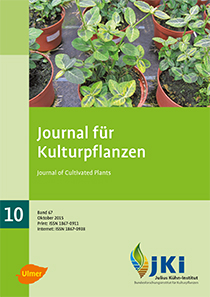Stem rot and wilt on <em>Euonymus</em>
Keywords:
Calonectria, Cylindrocladium, Euonymus, ornamental shrub, symptoms, morphology, sequence analysisAbstract
In August 2008, stem rot and wilt symptoms of unknown origin were observed on Euonymus japonica. From the symptomatic stem base a fungus belonging to the genus Calonectria (anamorph: Cylindrocladium) was isolated (isolate JKI 2140). The isolate was morphologically very similar to Calonectria colhounii as well as to Ca. fujianensis and Ca. pseudocolhounii, except for the larger conidia. Sequence analysis of genes (ITS, BT, TEF-1α, HIS3) showed high similarity to Ca. colhounii, Ca. eucalypti, Ca. fujianensis and Ca. pseudocolhounii. The taxonomic status of the fungal isolate from E. japonica is not yet clear. It belongs to the complex Ca. colhounii but a definitive allocation to or separation from a known Calonectria species is not possible on the basis of a single isolate. The fungus is provisionally named Calonectria colhounii compl.
The pathogenicity of the fungus was tested on E. japonica and E. fortunei. The disease symptoms originally observed on field plants of E. japonica were reproduced and the fungus was re-isolated. Thus the pathogenicity of isolate JKI 2140 on both Euonymus species is proved. Since the first occurrence of this infestation there were no further notifications of stem canker and wilt on Euonymus spp. in Germany. Therefore the importance of this pathogen on Euonymus is considered to be low.
DOI: 10.5073/JfK.2015.10.01, https://doi.org/10.5073/JfK.2015.10.01
Published
Issue
Section
License
The content of the journal is licensed under the Creative Commons Attribution 4.0 License. Any user is free to share and adapt (remix, transform, build upon) the content as long as the original publication is attributed (authors, title, year, journal, issue, pages).
The copyright of the published work remains with the authors. The authors grant the Journal of Cultivated Plants, the Julius Kühn-Institut and the OpenAgrar repository the non-exclusive right to distribute and exploit the work.







